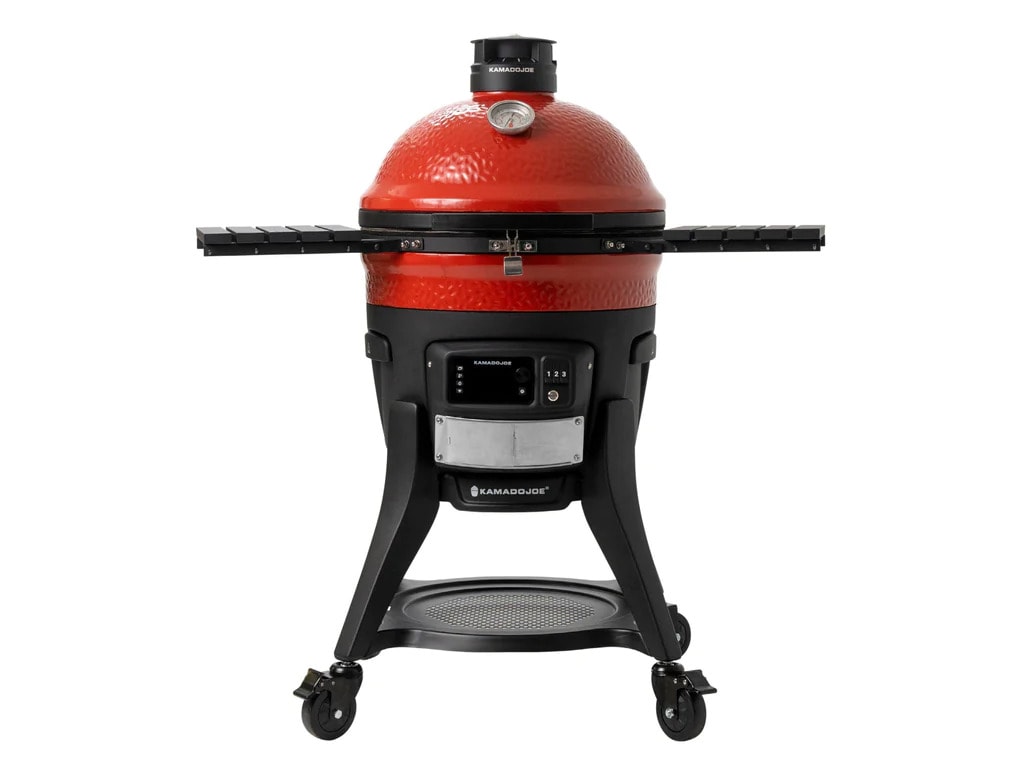Kamado Joe Konnected Joe review: A highly versatile smart grill
Typically, smart grills equal pellet grills. While pellet models played a key role in popularizing connected outdoor cooking, there are plenty of other options for controlling and monitoring things from the comforts of your living room. After introducing a smart controller for its ceramic grills in 2018, Kamado Joe released its own connected pellet version in 2020. Earlier this year, the company combined its add-on controller with its popular charcoal-burning red cookers, resulting in the Konnected Joe.
At first glance, the Konnected Joe looks like any other ceramic grill in Kamado Joe’s lineup. However, the bottom half is black where most of the company’s other options are solid red. The display (or Kontrol Board) also sets the Konnected Joe apart, and it’s situated beside three food probe jacks, the power button and a temperature dial. Here, you can see temperature graphs, select a cook mode and receive alerts. The grill will also advise you on how to adjust the vents based on your selected temperature. Buttons on the left allow you to set timers and reconnect to WiFi, in addition to adjusting the display to show grill or food temperatures in large numbers visible from afar.
Kamado Joe Konnected Joe
Pros
- All the benefits of a regular Kamado Joe
- Automatic Fire Starter saves time
- Monitor and control temps from your phone
- Accessories expand versatility
- Charcoal and wood chunks
Cons
- Expensive
- Heavy
- App needs work
- Long cool down period
- Consistent temperature control takes practice
- Limited cooking space compared to pellet grills
The Konnected Joe retains a lot of the features that make the company’s ceramic grills great for your deck or patio. The Kontrol Tower top vent, Air Lift hinge and heavy-duty cart all make using the grill easier. Inside, the company’s two-tier Divide & Conquer design allows you to cook different foods at different temperatures by changing the proximity of the stainless steel grates to the fire. You can also set up one side for direct grilling while using a heat deflector for indirect on the other. Most of the components for the grill are semi-circular, which makes the Konnected Joe just as versatile as a regular Kamado Joe. The folding side shelves are modestly sized, but they’re enough to hold a plate, tray or small cutting board.
Kamado Joe’s latest smart grill is compatible with all of the accessories for the Classic Joe grill, except for the charcoal basket. This means you can add a rotisserie (JoeTisserie), pizza stone (DoJoe) and more to expand the capabilities of the Konnected Joe. There’s a ton of options here, ranging from the affordable half-moon reversible griddle ($70) to the pricey JoeTisserie ($300), with some bundles going for even more. You don’t need to purchase anything extra to get started with the Konnected Joe, though. The grill ships with grates, heat deflectors for low-and-slow cooking and all you need for that optional two-tier configuration.

Subscribe to the Engadget Deals Newsletter
Great deals on consumer electronics delivered straight to your inbox, curated by Engadget’s editorial team. See latest

Please enter a valid email address
Please select a newsletter
By subscribing, you are agreeing to Engadget’s Terms and Privacy Policy.
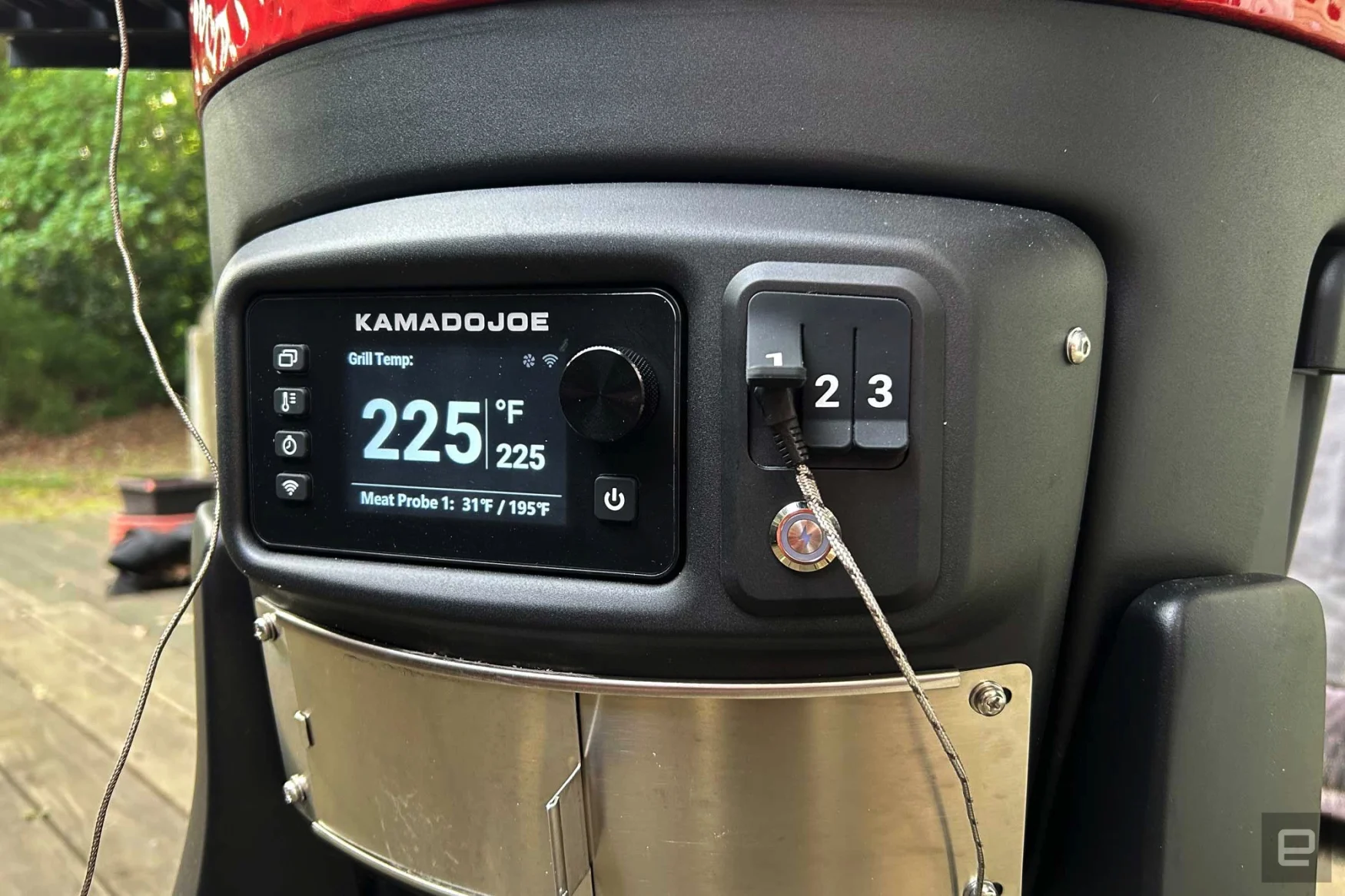
Just under the three food probe jacks is a dedicated button for the Automatic Fire Starter (AFS). WiFi connectivity may get the bulk of the attention on this Kamado Joe, but the AFS is the real star. It’s essentially a heating element at the bottom of the cooking chamber where you load your charcoal and wood chunks. When you turn it on, it runs for 15 minutes to light your charcoal without any additional lighter fluid or fire starters. I’ve used this every time I’ve cooked with the Konnected Joe, even when I’m otherwise running the grill in Classic Cook Mode without the automatic temperature control. It consistently, completely lit up the charcoal. See ya later, charcoal chimney.
In addition to built-in WiFi, another key aspect of smart grilling is a mobile app. The Kamado Joe App allows you to adjust time and temperature without being directly in front of the grill. During my tests, changes were typically quick although there have been a few times I had to input the desired temperature twice to get it to stick. Those temperature graphs from the onboard display are here as well, alongside the ability to browse recipes and monitor food probe temps. However, where Kamado Joe currently lags behind the competition is its library of recipes and how they’re presented.
Right now, there are over 150 recipes available in the Kamado Joe app, organized by food type and cooking method. For comparison, the Traeger app currently houses over 1,000. The Kamado Joe app is also missing a few glaring items, like pulled pork, but the company says it continuously adds new recipes. It also said it’s working to bring recipe videos and step-by-step guidance to the app sometime next year. These are two more items that both Traeger and Weber offer in their apps and they can be a big help when you’re trying a new recipe or are a beginner griller. Still, the app does a solid job with the basics of monitoring and controlling the grill.
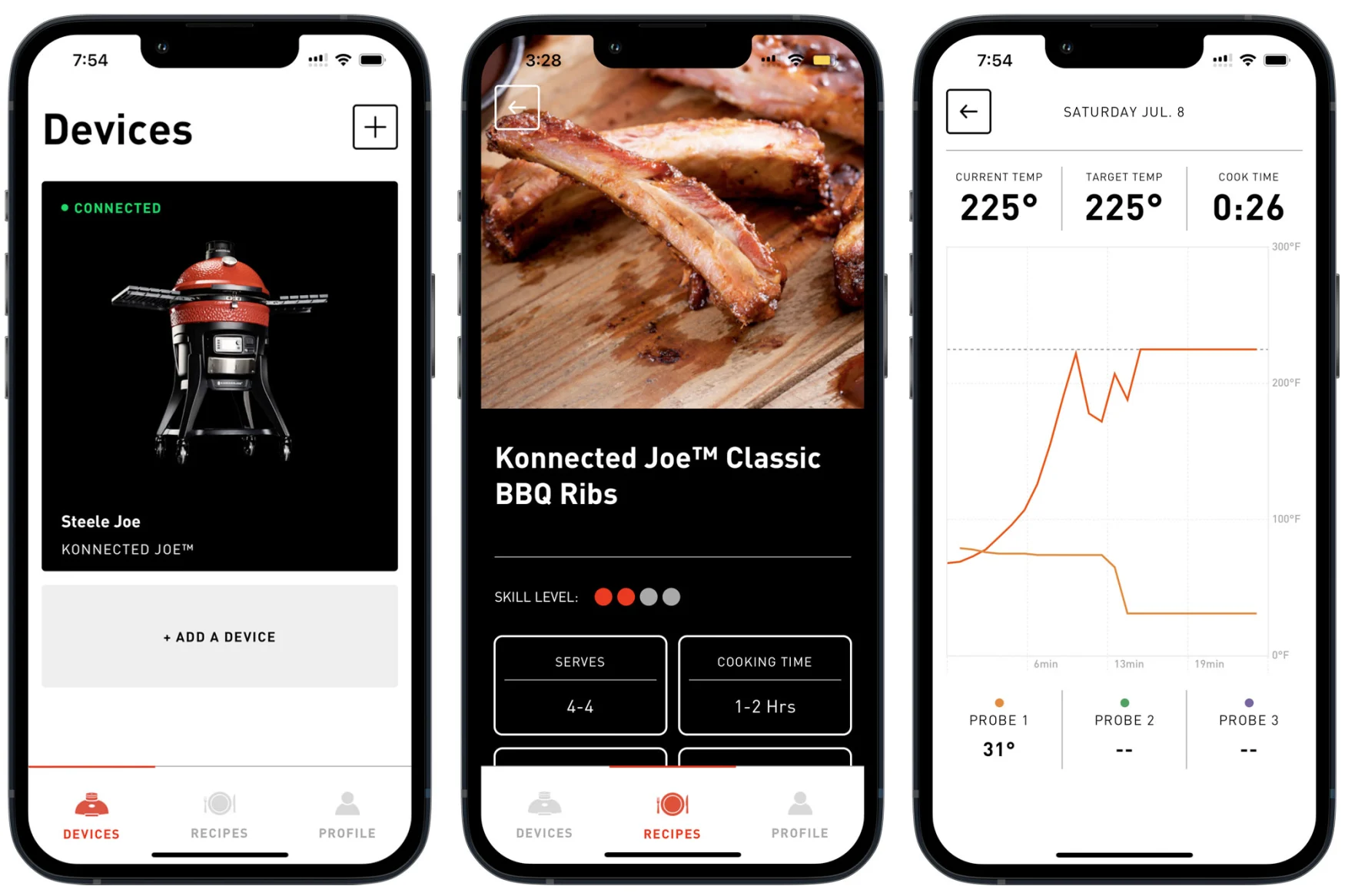
Another area the Kamado Joe app could offer guidance is preparing the grill to cook. There are some tips in recipes, like waiting for clean smoke when you add wood chunks before putting any food on, but there aren’t any tips on how much charcoal to add in the first place. This is a lesson I learned the hard way, as the Konnected Joe would consistently overshoot the set temperature during low-and-slow smoking in my initial tests.
After consulting with the company, I determined I was using too much charcoal and the extra fuel was igniting before I needed it during the longer sessions. Using less at the start fixed my problem, but extended cooking times may require you to add more. This means moving your food and any racks to the side to access the bottom of the chamber. It’s not ideal, but it’s hardly a dealbreaker.
None of this means much if the grill can’t produce great-tasting food, and the Konnected Joe does an excellent job in that regard. Since this is mostly a Kamado Joe ceramic grill with some smart-cooking bits added on, its performance is similar to those non-WiFi models. You get the flavor of charcoal, which has a more pronounced smoky essence than pellet grills produce. Sure, you can impart plenty of smoke with wood pellets, but what you get from charcoal is just different. And, at least to me, it’s slightly more intense. You also get the flavor of charcoal through direct cooking for a true grilled essence as opposed to hot-and-fast searing on a pellet grill.
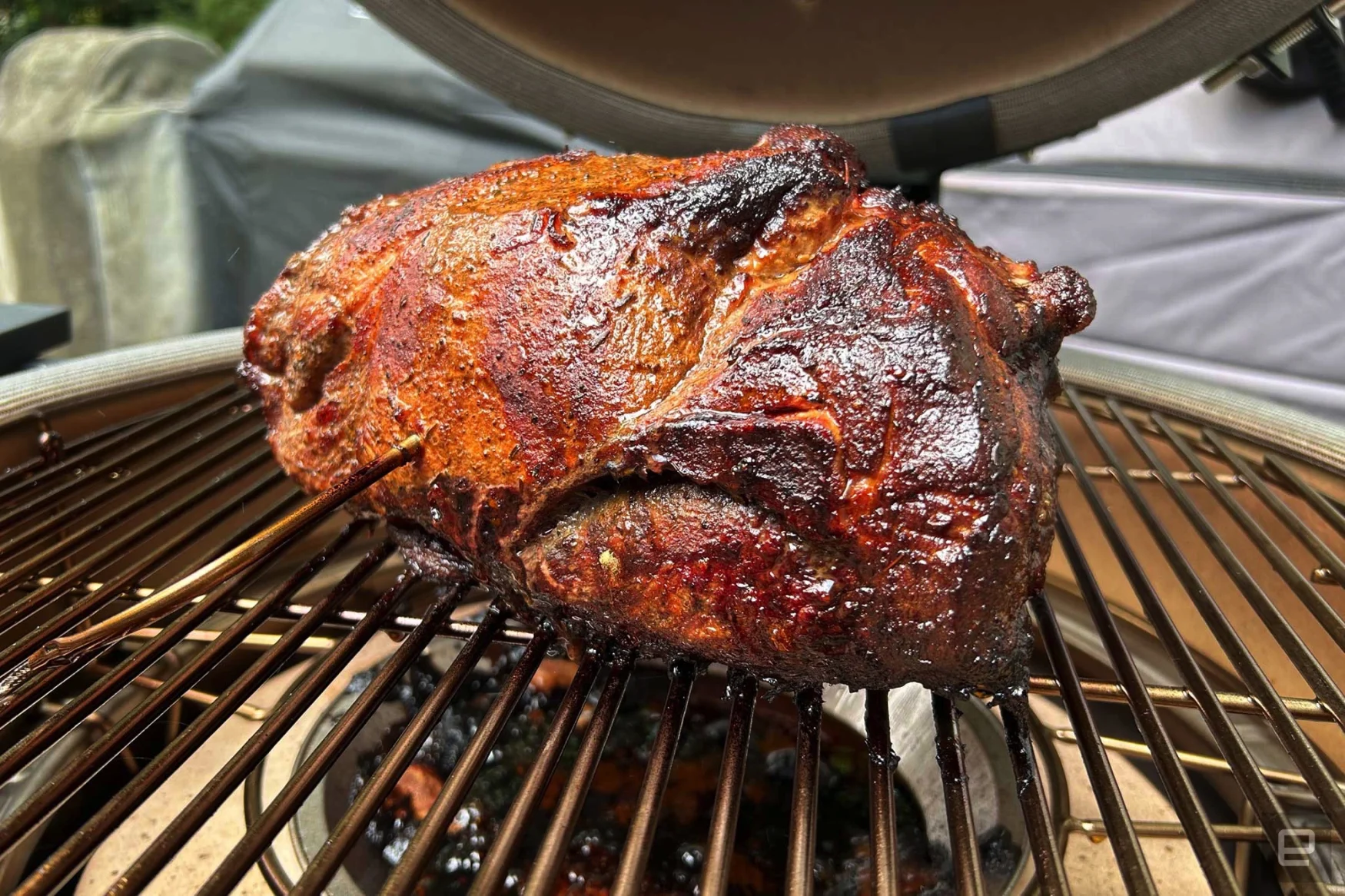
Over the course of testing, I did a mix of high-heat grilling and slow-smoked barbecue. This included a lot of steaks, a Boston Butt for pulled pork, baby back ribs and more. I was consistently impressed by the charcoal smoke flavor present in all of my cooks, especially in the longer sessions for the pork shoulder and ribs. What’s more, the Konnected Joe allows you a bit more room to experiment with types of wood as you add chunks to supplement the charcoal. There are different kinds of pellets intended for different foods, but sometimes those aren’t a single type of wood even if they’re labeled as such. For example, Weber’s Cherry pellets are 60 percent Maple. With the Konnected Joe, you can grab a bag of a single type of wood chunks (I use Kingsford) and change them up based on what you’re cooking.
Another thing you need to be aware of (and this applies to ceramic grills in general) is the long cool-down period. Due to the nature of the materials, these models retain heat a lot more efficiently than a kettle or gas grill – or even most pellet options. This is great while you’re cooking, but it also means you need to plan for an extended time for the grill to cool off before you can put the cover on. As an example, I finished cooking ribs around 5PM at a temperature of 275 degrees (a five-hour cook). When I locked up for the night around 11PM, the grill was still warm to the touch, so I couldn’t cover it yet. High-heat searing required even more time to cool off, and in most cases, I had to leave the grill uncovered until the next day.
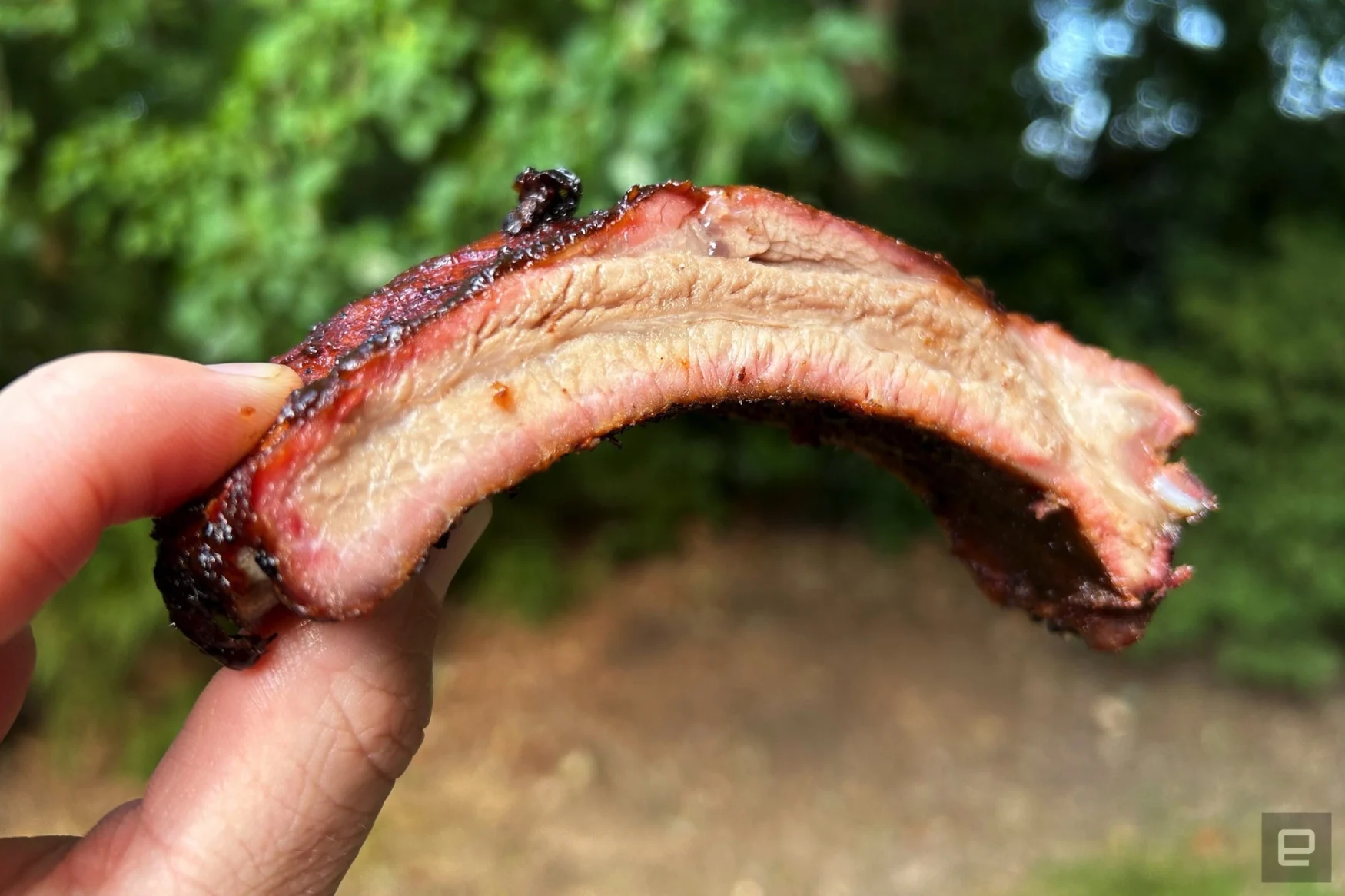
One area where the Konnected Joe surpasses WiFi-enabled pellet grills is the ease of cleanup. You only need to use the included ash tool to scrape debris through the holes in the bottom of the cooking chamber, leaving larger pieces of used charcoal for the next cook. A tray inside the bottom vent slides out for easy disposal. If there’s a large amount of ash, you may need to use the tool to scrape that slot, but you shouldn’t need to get out the shop vac like you do for a pellet grill. Of course, the accessories may require a thorough scrubbing after use, but that’s nothing some grill cleaner or soapy water can’t handle.
If you’re looking for a charcoal-burning alternative to the Konnected Joe, you don’t have to go far. Parent company Middleby Outdoor also owns the Masterbuilt brand that has the Gravity Series smart grills we tested in 2020. While the Gravity Series 560 was the first version, the company has since introduced the larger Gravity Series 800 that comes with a griddle insert and the Gravity Series 1050 with the largest cooking capacity of the trio.
The design is the same across all three models: a gravity-fed hopper on the right side funnels charcoal down to a digitally-controlled fan to maintain temperatures. You can add wood chunks to the ash bin to produce more smoke. The Gravity Series is capable of hot-and-fast searing, low-and-slow smoking and everything in between, all with the ability to monitor temperatures from your sofa. One key issue with those grills is they can be difficult to light when you have used charcoal at the bottom of the hopper, so it’s best to cycle through and have fresh fuel to light, mixing any used bits mid-chamber.
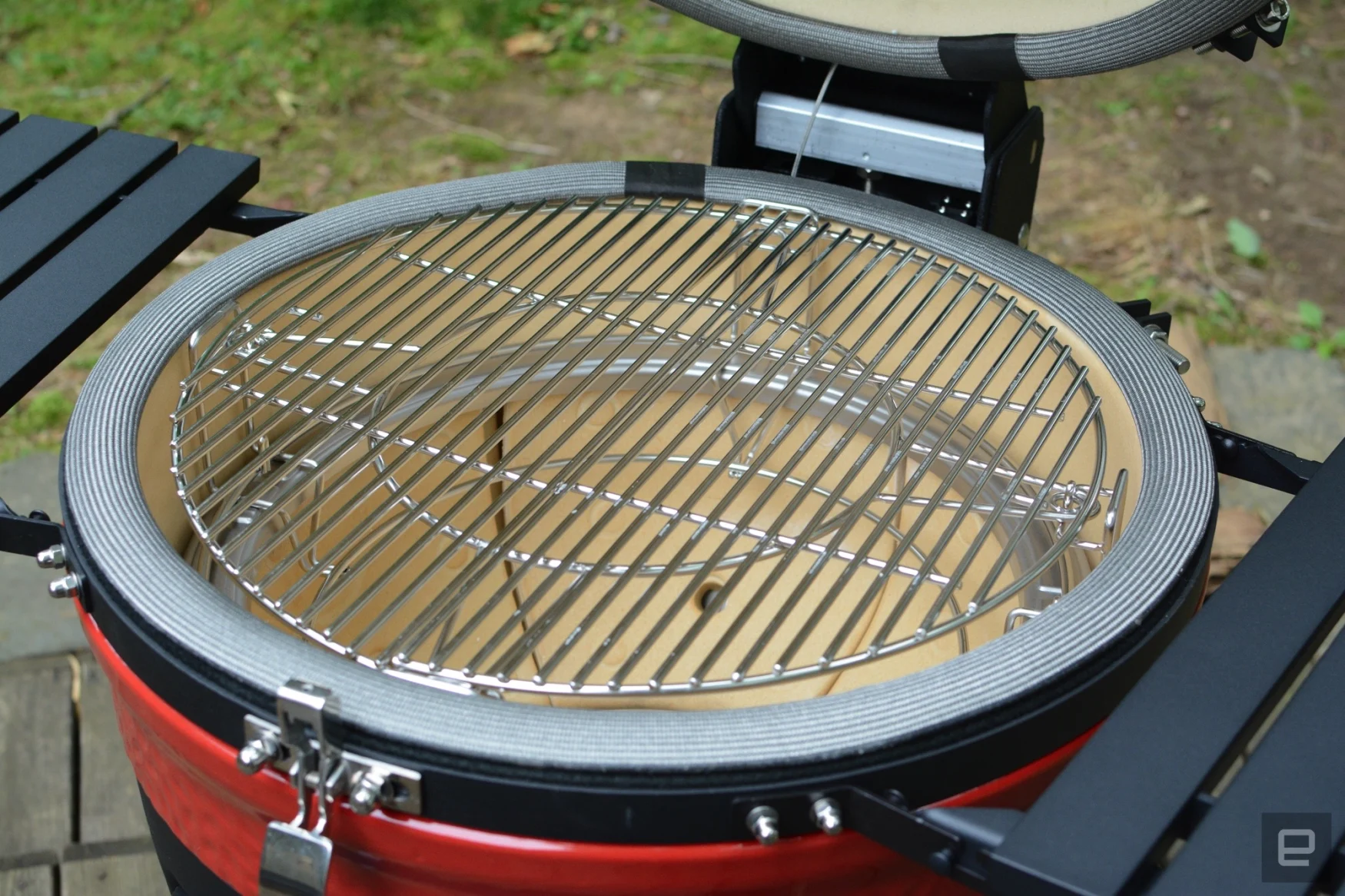
If ease of use is your top priority, a pellet model is worth considering when shopping for a smart grill. In addition to full-featured apps for monitoring and controlling the grill from afar, Traeger and Weber both offer easy-to-follow recipe guidance. Both companies also give you estimated completion times in their apps (via Meater for Traeger) so you have an idea of when to have the sides ready (and to keep hungry guests informed of the situation).
What’s more, pellet grills don’t require you to futz with components to add more fuel as you simply refill the hopper outside of the cooking area if you start to run low. Cleanup is a little more involved, but for longer cooks that don’t require any spritzing to keep the meat moist or wrapping to expedite cooking, this type of grill is truly set it and forget it. Weber’s most recent model is the SmokeFire Sear+, which offers over 1,000 square inches of cooking space for $1,599. The best new Traeger for most people is the recently redesigned Ironwood, the smaller version of which is $1,800.
At $1,699, the Konnected Joe is very expensive for a charcoal grill. However, it’s more affordable than the Classic Joe Series III, which offers the same cooking area without the connectivity and AFS igniter. A comparably sized Big Green Egg is around $1,100, but again, you’ll need a secondary device for any kind of temperature monitoring. When you pit it against WiFi-equipped pellet grills, the Konnected Joe isn’t that far off. In fact, it’s slightly cheaper than Kamado Joe’s own Pellet Joe. A connected grill and all the convenience that it affords has never been cheap, but the Konnected Joe pairs all the versatility of a ceramic cooker with the advantages of charcoal and performs well. If the company can expand and refine its companion app, this grill will be a complete package – even if it commands a steep investment.

